Lessons Learned from South Sudan Protection of Civilian Sites 2013–2016
1rTWN7V
1rTWN7V
Create successful ePaper yourself
Turn your PDF publications into a flip-book with our unique Google optimized e-Paper software.
32 - <strong>Lessons</strong> <strong>Learned</strong> <strong>from</strong> <strong>South</strong> <strong>Sudan</strong> <strong>Protection</strong> <strong>of</strong> <strong>Civilian</strong> <strong>Sites</strong> - UNMISS and the PoC <strong>Sites</strong><br />
<strong>Protection</strong> <strong>of</strong> <strong>Civilian</strong>s Mandate<br />
The findings and recommendations <strong>of</strong> two previous<br />
reports on the challenges faced by former UN Mission in<br />
<strong>Sudan</strong> (UNMIS) 1 and its successor, UNMISS, in carrying<br />
out the protection <strong>of</strong> civilian mandate prove to be just<br />
as relevant years later. In the first study <strong>of</strong> UNMIS 1,<br />
conducted by Ingrid Marie Breidlid and Jon Harald Sande<br />
Lie in 2011, the researchers found<br />
"<strong>Civilian</strong> protection actors and local government<br />
<strong>of</strong>ficials expressed considerable frustration over the<br />
UNMIS military, arguing there was no will or intention<br />
on the part <strong>of</strong> the military commanders to contribute<br />
to protection. And even if there had been such will<br />
among the commanders on the ground, they would<br />
have been unequipped for the assignment."<br />
"Some even questioned the capacity <strong>of</strong> the military to<br />
protect its own premises and staff, referring to several<br />
incidents <strong>of</strong> burglaries in the UNMIS compound. The<br />
commanders were also seen to be bound hand and foot<br />
due to their inability to take decisions without approval<br />
<strong>from</strong> the higher command. As one UN staff member<br />
lamented: ‘If a convoy is attacked the military troops<br />
would not even be able to shoot back unless they have<br />
a “go ahead” <strong>from</strong> the contingent commander.’ The<br />
military side was therefore seen as merely symbolic,<br />
not an actual protection force.” 29 (p. 18)<br />
Although there was change in mandate <strong>from</strong> Chapter VI<br />
to Chapter VII when UNMIS 1 changed to UNMISS in July<br />
2011, the challenges on the ground for the new mission<br />
persisted, even with a more robust mandate. A consequent<br />
assessment <strong>of</strong> the protection <strong>of</strong> civilians strategy in 2013<br />
by Jort Hemmer examined how overambitious the new<br />
mandate was. The report stated:<br />
“UNMISS’s broad and ambiguous mandate and overly<br />
ambitious PoC objectives have created and perpetuate<br />
expectations that it will never be able to meet. To break<br />
the cycle <strong>of</strong> unfulfilled promises and capitalize on its<br />
existing potential the recommendations to UNMISS’s<br />
leadership are to<br />
1. specify the mission’s understanding <strong>of</strong> an role in PoC;<br />
2. further prioritize its PoC activities on the basis <strong>of</strong> a realistic<br />
assessment <strong>of</strong> existing demands on the ground, the<br />
mission’s actual capabilities, its comparative advantages<br />
relative to other actors, and its political room to manoeuvre;<br />
3. review accordingly the resources it requires; and<br />
4. act decisively and- with an eye to its temporary stay in<br />
<strong>South</strong> <strong>Sudan</strong>- responsibility.” 30 (p. 1)<br />
It is telling that the findings and recommendations <strong>of</strong> these<br />
two reports, <strong>from</strong> five and three years ago, respectively, are<br />
still accurate and very applicable to the mission in 2016. A<br />
central point for UNMISS leadership, DPKO and member<br />
states is to recognize the primary challenges and make the<br />
necessary reforms and improvements. Over the past five<br />
years, self-reflection on shortcomings has not produced<br />
practical policy change.<br />
Years later, the same recommendations <strong>from</strong> 2011 and<br />
2013 were again reiterated in interviews with key UNMISS<br />
staff. For example, the former military chief <strong>of</strong> staff, Petter<br />
Lindqvist, lamented that “the eternal predicament I faced<br />
as UNMISS chief <strong>of</strong> staff was that the mission was trying<br />
to do everything and be everywhere. UNMISS had difficulty<br />
prioritizing” (12 January 2016). In consequence, UNMISS has<br />
contributed to creating unrealistic expectations regarding its<br />
capability to protect civilians. Some factors, such as a lack<br />
<strong>of</strong> troops, funding and logistical and access constraints will<br />
continue to be restrictive and limit UNMISS’s capability to<br />
project outside their bases.<br />
The mission is challenged by unrealistic expectations,<br />
prioritization <strong>of</strong> its limited assets and forces, the repeated<br />
violations <strong>of</strong> the Status <strong>of</strong> Forces Agreement (SOFA) by the<br />
government and the perception <strong>of</strong> UNMISS forces as s<strong>of</strong>t<br />
targets. Repeated perimeter breaches <strong>of</strong> its own bases, and<br />
the attacks on the Bor PoC site in April 2014 and Malakal<br />
PoC site in February 2016, particularly, reinforce the<br />
impression that if forces cannot even protect themselves<br />
or civilians in their bases, then they are unable to protect<br />
civilians outside (see case study on the right).<br />
In certain cases, such as the attack on Akobo in December<br />
2013, the reported large numbers <strong>of</strong> civilian attackers<br />
prevented an adequate response by UNMISS peacekeeping<br />
forces deployed to the base. 31 However, there have also<br />
been many cases where UNMISS failed to protect civilians<br />
within their base and adjacent to their perimeters. A<br />
recent piece in the New York Times states that, in 2015,<br />
“Government soldiers and affiliated militias in particular<br />
attacked and harassed civilians moving in and out <strong>of</strong> the<br />
centers, abducting or killing them, raping some women and<br />
looting, the United Nations reported. At least 39 people were<br />
killed in the vicinity <strong>of</strong> one <strong>of</strong> the sites at Bentiu between<br />
January and October.” 32<br />
29 I.M. Breidlid and J. Harald Sande Lie, 2011.<br />
30 J. Hemmer, “We are laying the groundwork for our own failure: The UN Mission in <strong>South</strong><br />
<strong>Sudan</strong> and its civilian protection strategy: an early assessment.” CRU Policy Brief No. 2<br />
(January 2013).<br />
31 UNMISS, 20 December 2013.<br />
32 N. Cumming-Bruce, 2016 referencing UNMISS and OHCHR, “The State <strong>of</strong> Human Rights in<br />
the Protracted Conflict in <strong>South</strong> <strong>Sudan</strong>”(4 December 2015).


